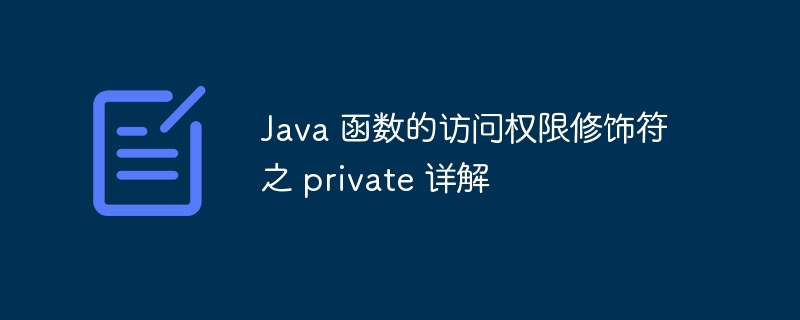Detailed explanation of private access modifiers for Java functions
private is a Java access modifier that restricts the accessibility of a function to only the class in which it is defined, including: the function cannot be accessed in other classes. The function is also not accessible in subclasses.

Detailed explanation of private access modifier of Java function
In Java, private is an access modifier. It is used to limit the accessibility of functions. It is the most restrictive access modifier, allowing access to the function only within the class in which it is defined.
Syntax
private The modifier is applied before the function declaration, the syntax is as follows:
private void functionName() {
// 函数体
}Access rules
Use Functions modified by the private modifier can only be accessed within the same class. This means:
- The function cannot be accessed from other classes.
- This function cannot be accessed from subclasses.
Practical case
Let us create a class named Person and define a private function in it to get the age:
class Person {
private int age;
public void setAge(int age) {
this.age = age;
}
// `private` 函数只能在这个类中访问
private int getAge() {
return age;
}
}In the main method, we cannot directly access the getAge() function because it is declared as private:
public class Main {
public static void main(String[] args) {
Person person = new Person();
person.setAge(25);
// 编译器错误:getAge() 函数是私有的
// int age = person.getAge();
}
}In order to get the age, we need to set the age through the public function setAge() , and then use the getter function to get the age:
public class Main {
public static void main(String[] args) {
Person person = new Person();
person.setAge(25);
int age = person.getAge(); // 通过 getter 函数获取年龄
}
}The above is the detailed content of Detailed explanation of private access modifiers for Java functions. For more information, please follow other related articles on the PHP Chinese website!

Hot AI Tools

Undresser.AI Undress
AI-powered app for creating realistic nude photos

AI Clothes Remover
Online AI tool for removing clothes from photos.

Undress AI Tool
Undress images for free

Clothoff.io
AI clothes remover

AI Hentai Generator
Generate AI Hentai for free.

Hot Article

Hot Tools

Notepad++7.3.1
Easy-to-use and free code editor

SublimeText3 Chinese version
Chinese version, very easy to use

Zend Studio 13.0.1
Powerful PHP integrated development environment

Dreamweaver CS6
Visual web development tools

SublimeText3 Mac version
God-level code editing software (SublimeText3)

Hot Topics
 Square Root in Java
Aug 30, 2024 pm 04:26 PM
Square Root in Java
Aug 30, 2024 pm 04:26 PM
Guide to Square Root in Java. Here we discuss how Square Root works in Java with example and its code implementation respectively.
 Perfect Number in Java
Aug 30, 2024 pm 04:28 PM
Perfect Number in Java
Aug 30, 2024 pm 04:28 PM
Guide to Perfect Number in Java. Here we discuss the Definition, How to check Perfect number in Java?, examples with code implementation.
 Random Number Generator in Java
Aug 30, 2024 pm 04:27 PM
Random Number Generator in Java
Aug 30, 2024 pm 04:27 PM
Guide to Random Number Generator in Java. Here we discuss Functions in Java with examples and two different Generators with ther examples.
 Weka in Java
Aug 30, 2024 pm 04:28 PM
Weka in Java
Aug 30, 2024 pm 04:28 PM
Guide to Weka in Java. Here we discuss the Introduction, how to use weka java, the type of platform, and advantages with examples.
 Armstrong Number in Java
Aug 30, 2024 pm 04:26 PM
Armstrong Number in Java
Aug 30, 2024 pm 04:26 PM
Guide to the Armstrong Number in Java. Here we discuss an introduction to Armstrong's number in java along with some of the code.
 Smith Number in Java
Aug 30, 2024 pm 04:28 PM
Smith Number in Java
Aug 30, 2024 pm 04:28 PM
Guide to Smith Number in Java. Here we discuss the Definition, How to check smith number in Java? example with code implementation.
 Java Spring Interview Questions
Aug 30, 2024 pm 04:29 PM
Java Spring Interview Questions
Aug 30, 2024 pm 04:29 PM
In this article, we have kept the most asked Java Spring Interview Questions with their detailed answers. So that you can crack the interview.
 Break or return from Java 8 stream forEach?
Feb 07, 2025 pm 12:09 PM
Break or return from Java 8 stream forEach?
Feb 07, 2025 pm 12:09 PM
Java 8 introduces the Stream API, providing a powerful and expressive way to process data collections. However, a common question when using Stream is: How to break or return from a forEach operation? Traditional loops allow for early interruption or return, but Stream's forEach method does not directly support this method. This article will explain the reasons and explore alternative methods for implementing premature termination in Stream processing systems. Further reading: Java Stream API improvements Understand Stream forEach The forEach method is a terminal operation that performs one operation on each element in the Stream. Its design intention is






